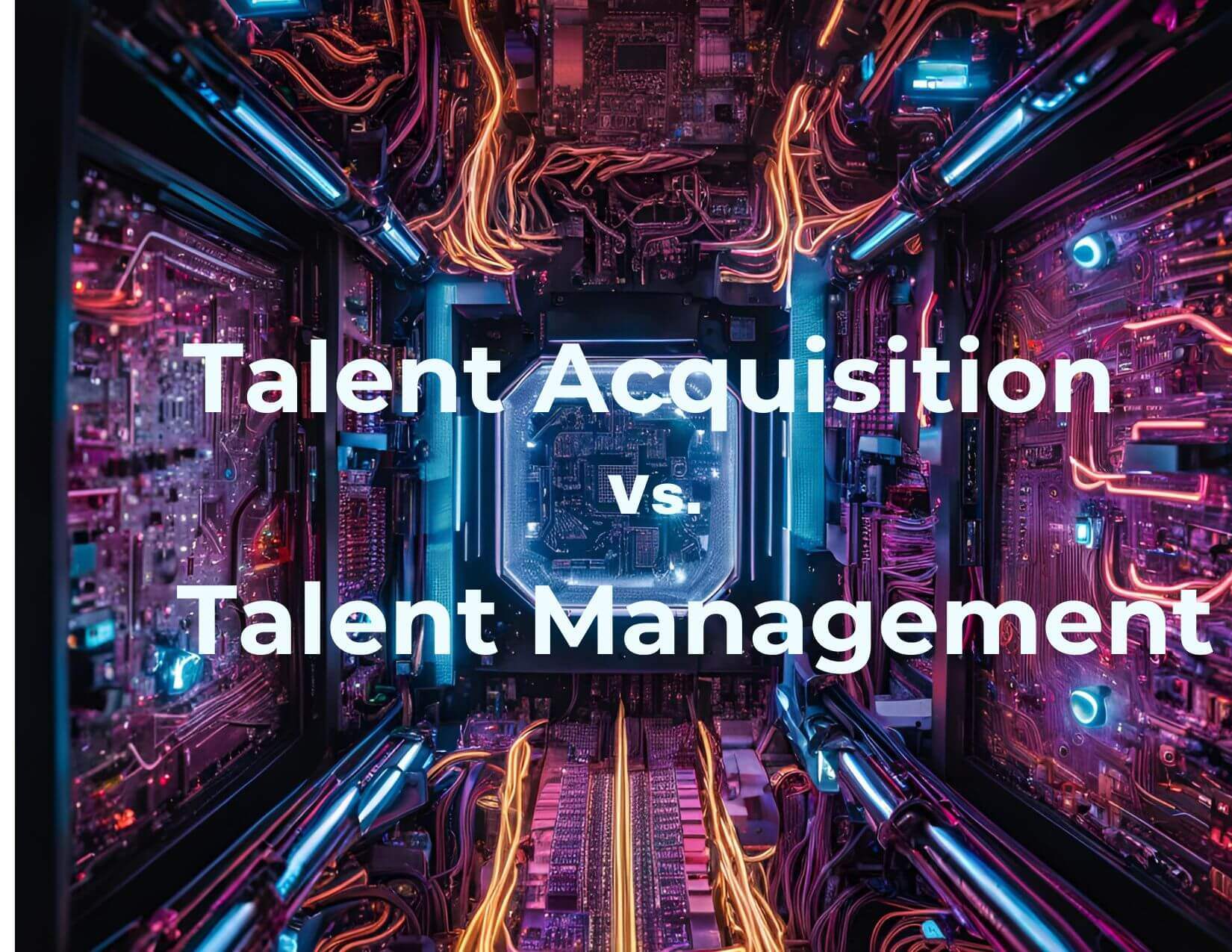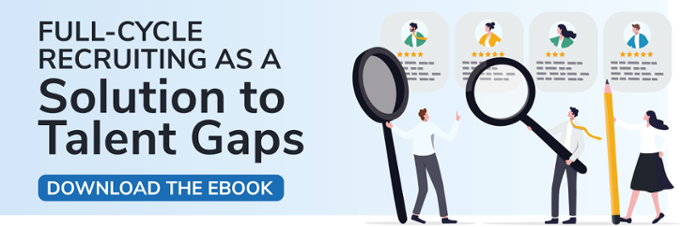Topic Talent Acquisition
Talent Acquisition vs Talent Management: How to Build Better Organizations

October 9, 2024 | By Questco Companies

In the competitive world of business, an organization's success often hinges on its people. For HR professionals and business owners, understanding the intricacies of talent acquisition and talent management is essential as these two vital processes help build a skilled workforce and create an environment where employees thrive.
In this guide, we will unpack the nuances between talent acquisition and talent management, exploring how you can make them work together to drive your organization’s success.
Talent Acquisition vs Talent Management Unveiled
At first glance, talent acquisition and talent management might seem similar. Both are integral parts of HR and cultivating a thriving workforce, but they serve distinct purposes. While talent acquisition is about bringing new talent into an organization, talent management focuses on nurturing and retaining that talent.
So, if we’re using a house as a reference, talent acquisition would be the outside water supply, providing access from the broader water network that services your entire region. Talent management would be the interior plumbing and water heating that controls the flow and temperature coming through your tap.
Both work together and need each other. If your area doesn’t have clean water, your house would need to install additional filters or boil water to make it safe – just like how you may need to adjust training procedures depending on how likely you’ll find candidates who match your industry knowledge.
Let’s explore these processes in detail and explain how you can leverage them effectively.
Understanding Talent Acquisition
Talent acquisition is the process of attracting, identifying, and hiring candidates who meet your organization's needs through a combined process of cultivating an employer brand and communicating job needs. It goes beyond simply filling vacancies and involves strategically sourcing talent that aligns with your company's goals. It’s a combined process that involves job sourcing, employer branding, and delivering a positive candidate experience to demonstrate your value as an employer so you can attract talented people who will help grow your company.
The acquisition process begins with defining what skills and roles are needed within the organization, which requires an understanding of current workforce dynamics and predicting future needs. Once the requirements are clear, HR professionals can define the job role and list the necessary qualifications. Once those are outlined, they can begin sourcing candidates through various channels, ensuring a diverse and qualified pool of applicants.
Conducting the Recruitment Process
Recruitment is a core part of talent acquisition that focuses on identifying and selecting candidates. With the job descriptions in mind and posted, HR teams source potential candidates, screen applications, and conduct interviews to find the best fit for the role. A well-structured recruitment process involves several stages, each crucial for finding the right talent. From job postings to final interviews, every step should reflect the organization's values and culture. The goal is not only to fill positions but also to attract individuals who will contribute positively to the workplace.
Strategies and Challenges with Talent Acquisition
Developing a robust talent acquisition strategy involves several key components. Investing in employer branding is crucial, as it represents your organization's identity and values to potential candidates. This attracts individuals who resonate with your culture and possess the necessary skills.
However, every company faces challenges with it too. Organizations often compete for top talent, navigating evolving skill requirements and market dynamics. Innovative strategies are essential to stand out and attract the right candidates amidst these challenges. Paying attention to changing expectations and adapting to offer the benefits workers want – like increased flexibility in addition to things like healthcare and retirement plans – helps keep your workplace competitive even if you cannot compete on things like wages.
Understanding Talent Management
Once talent is acquired, the focus shifts to talent management. This process is about nurturing and developing the skills of employees within the organization. It's a delicate balance between helping employees contribute to company success and achieving their personal career goals. Effective talent management creates an environment where employees feel valued, engaged, and motivated.
Talent management is not a one-size-fits-all approach. It requires understanding each employee's unique needs and providing opportunities for growth and development. This might involve personalized career paths, mentorship programs, and regular feedback to ensure employees are on track toward success.
Implementing Talent Management
Implementing talent management involves several key components. Performance management is crucial, providing feedback and evaluating employees' progress to help them grow in their roles. Learning and development opportunities further upskill employees, giving them new abilities to advance in their careers. Career pathing and succession planning are also vital. They provide clear direction for employees, showing them there are growth opportunities within the company. Engagement and retention strategies create a positive work environment, reducing turnover and keeping valuable knowledge within the organization.
Strategies and Challenges to Talent Management
Creating a culture of continuous learning is a hallmark of successful talent management. Encouraging employees to take on new skills, paired with a performance evaluation system, helps measure progress and identify areas for improvement. A positive work environment makes employees more comfortable in their roles, enhancing satisfaction and productivity.
However, retaining ambitious employees and adapting to their evolving needs pose challenges. Organizations must stay agile, continuously re-evaluating and adjusting their talent management strategies to meet the demands of a dynamic workforce.
Marking the Distinctions between Talent Acquisition and Management
While both talent acquisition and management are essential, they differ significantly in focus and objectives. Talent acquisition looks outward, focusing on sourcing, recruiting, and hiring skilled employees. In contrast, talent management looks inward, developing, retaining, and optimizing employees after they have been hired.
The objectives also differ. Talent acquisition aims to attract top talent from outside the organization, ensuring the right individuals are placed in the right roles. Talent management ensures that existing employees are engaged and motivated, contributing to organizational goals while also achieving personal and professional growth that makes them better in their roles. Success indicators also differ. In talent acquisition, success is measured by the quality of hires, time-to-fill, and cost-per-hire. In talent management, success is indicated by employee retention rates, employee satisfaction, and the development of future leaders within the organization.
In the world of human resources, two strategies stand out as pillars of workforce management—talent acquisition and talent management. While they are interconnected, each serves a distinct purpose within an organization. Understanding the difference between these two approaches is crucial for business owners and HR professionals alike. In this blog, we will explore the nuances of talent acquisition and talent management, helping you leverage both strategies to foster a thriving workforce.
Key Activities in Talent Acquisition and Management
The activities involved in talent acquisition and management highlight their unique functions within an organization.
Talent acquisition activities encompass job advertising, applicant screening, interviewing, and onboarding. Job advertising involves creating compelling job descriptions and leveraging various channels to reach potential candidates. Applicant screening filters resumes to identify qualified individuals, while interviews assess candidates' suitability for the role and the company. Once selected, onboarding activities help new hires acclimate to the organization and integrate into their teams successfully.
Talent management involves a broader range of activities, including performance management, training and development, succession planning, and employee appraisal. Performance management involves setting clear expectations, providing regular feedback, and conducting performance reviews to ensure employees meet their goals. Training and development focus on enhancing skills and knowledge, enabling employees to grow and advance in their careers. Succession planning identifies potential future leaders and prepares them for higher responsibilities, ensuring continuity in leadership. Employee appraisal assesses performance and identifies areas for improvement, fostering a culture of continuous growth.
Combining Your Strategies to Build Organizational Success
Understanding the differences between talent acquisition and talent management is crucial for business owners and HR professionals. Both processes are vital, each with its focus, objectives, and measures of success. To build a talented workforce, your HR team must align talent acquisition and talent management strategies. These processes should complement each other, ensuring a steady balance of new and existing employees. Enacting them from one entity keeps your business aligned and working toward your goals by maintaining a steady stream of talented workers along with an invested and knowledgeable base of workers.
If this process seems daunting – it doesn’t have to be. Working with an HR partner like Questco lets you use their expertise to seamlessly integrate these processes, creating a unified strategy that supports your organization's success. By understanding and leveraging the differences and synergies between talent acquisition and management, your business can thrive.
Reach out today to learn how Questco can enhance your talent strategies and create a winning organizational culture.







